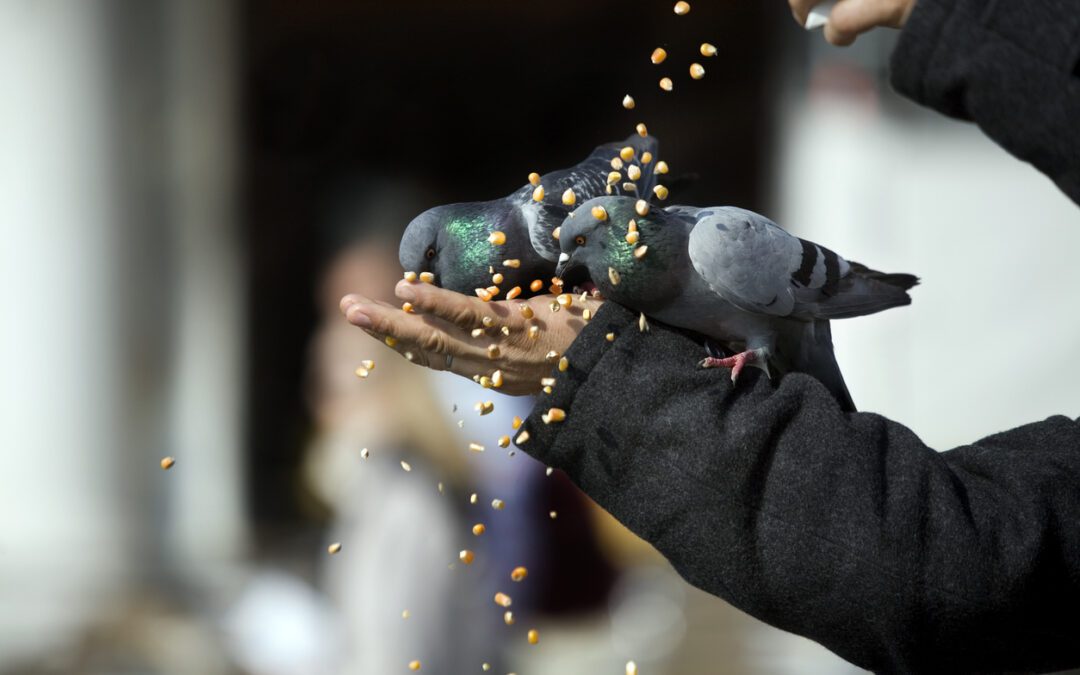
by Pigeon Patrol | Oct 15, 2024 | Bird Deterrent Products, Bird Law, Bird Netting, Bird Spikes, Columbidae
Nearly three-quarters of Big Apple kids may have been exposed to a pigeon-poop fungus that can cause vomiting, fever and other illnesses, a new study revealed yesterday.
According to researchers at Albert Einstein College of Medicine in The Bronx, 70 percent of urban kids are exposed to Cryptococcus neoforman fungus, which grows in rotting pigeon roosts and is present in pigeon droppings.
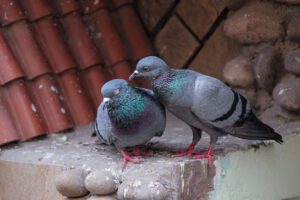
Moment of tenderness between a pair of pigeons
The researchers took blood samples from 185 healthy Bronx children and found that seven out of ten of those over the age of five, and 56 percent younger than five, were infected by the fungus.
Expert say the airborne fungus – which remains until adulthood – may be an underlying cause of many mysterious cases of vomiting, fever and lethargy.
“We were surprised by the number of children exposed to this fungus,” said Dr. David Goldman, and assistant professor of pediatrics at the medical school.
“It’s all over because pigeons are common in cities all over the world,” Goldman said.
The infection, which also can be caused by parrots, canaries and other birds, can be treated with anti-fungal medications.
Cryptococcus neoforman enters the body through the lungs and spreads to other tissues and organs, especially the brain.
It is normally KO’d by the body’s natural defenses, but in people with weakened immune systems, like those with AIDS and cancer, the fungus can cause meningitis, a brain infection that is often fatal.
Pigeon Patrol Products & Services is the leading manufacturer and distributor of bird deterrent (control) products in Canada. Pigeon Patrol products have solved pest bird problems in industrial, commercial, and residential settings since 2000, by using safe and humane bird deterrents with only bird and animal -friendly solutions. At Pigeon Patrol, we manufacture and offer a variety of bird deterrents, ranging from Ultra-flex Bird Spikes with UV protection, Bird Netting, 4-S Bird Gel and the best Ultrasonic and audible sound devices on the market today.
Canada’s top wholesaler for bird deterrent products for twelve consecutive years.
Contact us at 1- 877– 4– NO-BIRD, (604) 585-9279 or visit our website at https://www.pigeonpatrol.ca/
Bird Gone, Pigeon Gone, Pigeon problems, pigeon spikes, 1-877-4NO-BIRD, 4-S Gel, Bird Control, Pigeon Control, bird repellent, Bird Spikes, sonic bird repellent, stainless steel bird spikes, bird spikes Vancouver, Ultra Sonic Bird Control, Bird Netting, Plastic Bird Spikes, Canada bird spike deterrents, Pigeon Pests, B Gone Pigeon, Pigeon Patrol, pest controller, pest control operator, pest control technician, Pigeon Control Products, humane pigeon spikes, pigeon deterrents, pigeon traps, Pigeon repellents, Sound & Laser Deterrents, wildlife control, raccoon, skunk, squirrel deterrent, De-Fence Spikes, Dragons Den, Pigeon, Pigeon Patrol, Pigeons Roosting, Vancouver Pigeon Control, Bird Spikes, Bird Control, Bird Deterrent, Pigeon Deterrent, Surrey Pigeon Control, Pest, Seagull deterrent Vancouver Pigeon Blog, Birds Inside Home De-fence, Pigeon Nesting, Bird Droppings, Pigeon Dropping, woodpecker control, Keep The Birds Away, Birds/rats, seagull, pigeon, woodpecker, dove, sparrow, pidgeon control, pidgeon problem, pidgeon control, flying rats, pigeon Problems, bird netting, bird gel, bird spray, bird nails, bird guard, Pigeon control, Bird deterrents, Pigeon deterrents, Bird control, solutions, Pigeon prevention, Pigeon repellent, Bird proofing, Pest bird management, Pigeon spikes, Bird netting, Humane bird control, Bird exclusion, Urban bird control, Anti-roosting devices, Pigeon removal, Bird barriers
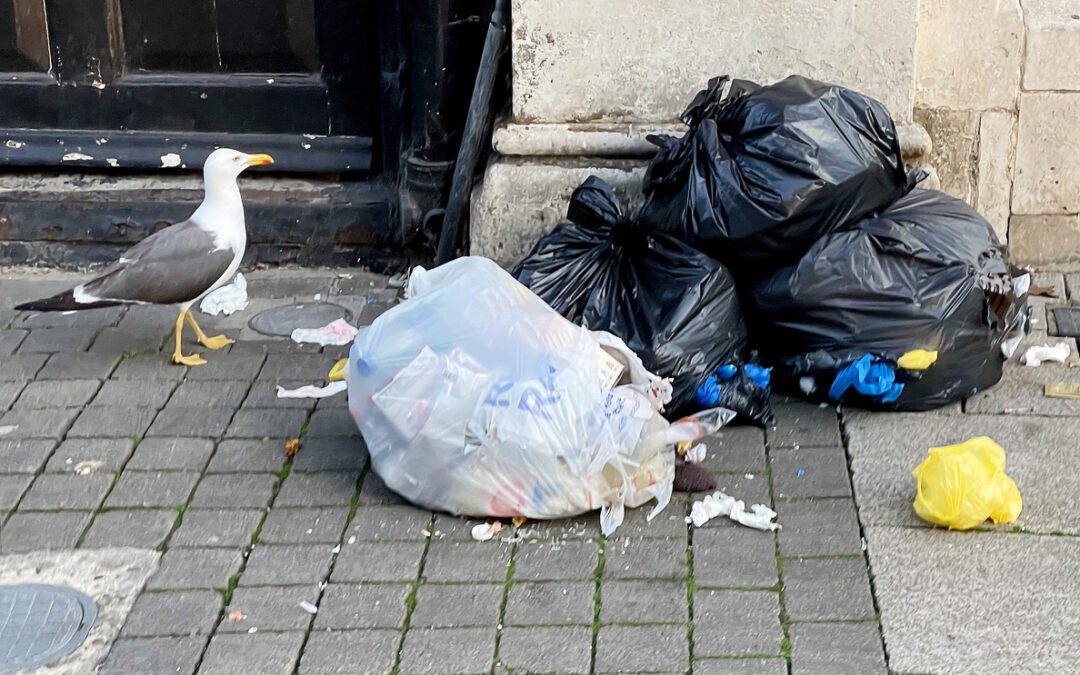
by Pigeon Patrol | Sep 25, 2024 | Bird Netting, Pigeon Control, Pigeon Droppings, Pigeon Patrol's Services
Fires were caused by a mouse chewing wires, a toilet roll being microwaved and a pigeon with a cigarette
A pigeon dropping a discarded cigarette down a chimney was among the most unusual causes of London fires in 2013, the city’s fire brigade has revealed.
Researchers studied 2,000 incidents in the capital in a bid to highlight the importance of fire safety.
Another case saw a fire caused by a dog hitting a toaster’s controls as it leapt on a worktop to reach food
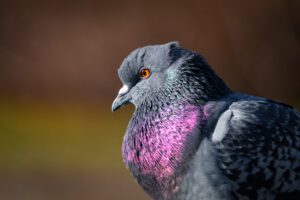
Close-up of a Pigeon at a Vancouver Island park.
.
London Fire Brigade (LFB) investigator Charlie Pugsley said he had seen some “weird and wonderful” things this year.
He added that even the strangest fire could have been prevented by taking simple fire safety precautions.
Other cases which highlighted the more unusual causes of fire included a teenage boy lighting a can of deodorant he had just used on himself ahead of his first date.
The LFB also attended fires started by someone putting a toilet roll which dropped down the loo into a microwave to dry it out and by a mouse eating through the wiring in the back of a fridge freezer.
Mr Pugsley said people should not use microwaves to dry out clothes or other items.
He added that candles should not be left unattended and mirrors and glass, which reflect the sun’s rays, needed to be kept away from flammable objects.
Pigeon Patrol
Pigeon Patrol Products & Services is the leading manufacturer and distributor of bird deterrent (control) products in Canada. Pigeon Patrol products have solved pest bird problems in industrial, commercial, and residential settings since 2000, by using safe and humane bird deterrents with only bird and animal -friendly solutions. At Pigeon Patrol, we manufacture and offer a variety of bird deterrents, ranging from Ultra-flex Bird Spikes with UV protection, Bird Netting, 4-S Bird Gel and the best Ultrasonic and audible sound devices on the market today.
Canada’s top wholesaler for bird deterrent products for twelve consecutive years.
Contact us at 1- 877– 4– NO-BIRD, (604) 585-9279 or visit our website at https://www.pigeonpatrol.ca/
Bird Gone, Pigeon Gone, Pigeon problems, pigeon spikes, 1-877-4NO-BIRD, 4-S Gel, Bird Control, Pigeon Control, bird repellent, Bird Spikes, sonic bird repellent, stainless steel bird spikes, bird spikes Vancouver, Ultra Sonic Bird Control, Bird Netting, Plastic Bird Spikes, Canada bird spike deterrents, Pigeon Pests, B Gone Pigeon, Pigeon Patrol, pest controller, pest control operator, pest control technician, Pigeon Control Products, humane pigeon spikes, pigeon deterrents, pigeon traps, Pigeon repellents, Sound & Laser Deterrents, wildlife control, raccoon, skunk, squirrel deterrent, De-Fence Spikes, Dragons Den, Pigeon, Pigeon Patrol, Pigeons Roosting, Vancouver Pigeon Control, Bird Spikes, Bird Control, Bird Deterrent, Pigeon Deterrent, Surrey Pigeon Control, Pest, Seagull deterrent Vancouver Pigeon Blog, Birds Inside Home De-fence, Pigeon Nesting, Bird Droppings, Pigeon Dropping, woodpecker control, Keep The Birds Away, Birds/rats, seagull, pigeon, woodpecker, dove, sparrow, pidgeon control, pidgeon problem, pidgeon control, flying rats, pigeon Problems, bird netting, bird gel, bird spray, bird nails, bird guard, Pigeon control, Bird deterrents, Pigeon deterrents, Bird control, solutions, Pigeon prevention, Pigeon repellent, Bird proofing, Pest bird management, Pigeon spikes, Bird netting, Humane bird control, Bird exclusion, Urban bird control, Anti-roosting devices, Pigeon removal, Bird barriers

by Pigeon Patrol | Sep 25, 2024 | Bird Netting, Bird Spikes
How to represent a city as old, sprawling, and populous as London? The London Museum shocked the internet when it debuted its new logo: a humble pigeon who, as the locals might say, has just gone to the loo. Looking a bit less dingy grey than usual, the gleaming white porcelain pigeon is accompanied by a glittering gold splatter of bird droppings.
According to a blog post, the newly rechristened London Museum (formerly the Museum of London) chose this quintessential urban bird as a symbol for the U.K. capital because it has remained “an impartial and humble observer of London life” for nearly 1,000 years.
The controversial logo has been designed by Uncommon Creative Studio, who enlisted the help of 33 Londoners from 32 boroughs, including a chef, a DJ, a children’s TV producer, a boxer, and a tattoo artist. They collaborated on the logo via workshops and focus groups, informed by the input of hundreds more Londoners whose opinions were solicited via survey.
“A good logo gets people talking,” said the museum’s director Sharon Ament. “The pigeon and splat speak to a historic place full of dualities, a place where the grit and the glitter have existed side by side for millennia.”
The pigeon has split opinion online, with some believing it to be a humorous homage to city life while others have found it “baffling,” in the words of Maxwell Blowfield, author of the popular “maxwell museums” newsletter. “No one ever thinks, feels or speaks about pigeons,” he said. “They’re one of the least unique things about London.”

Romantic day out with pigeons in the Amsterdam main square for a diverse tourist couple made up of an alternative brunette female and a curly transgender woman
“London is a remarkable place,” he added. “Yet the London Museum has has managed to avoid representing anything remarkable about it in this rebrand. Which is in itself remarkable.”
So what is the history of pigeons in London? The birds are descended from rock doves and were domesticated in the U.K. at around the time of the Norman Conquest, in 1066, as a food source as well as for long-distance communication. Some managed to escape, becoming the feral pigeons that roam free today.
A white clay Roman figurine of a pigeon from the 1st century C.E. is in the London Museum’s collection, speaking to this origin story.
In more recent centuries, some Londoners have taken kindly to pigeons. In the Victorian era, it became common for people to sell bags of bird seed to visitors to give to the pigeons. This was particularly commonplace in Trafalgar Square, as in one scene by Harold Dearden in the 1950s.
Another “little old bird woman” is described each morning on the steps of St. Paul’s Cathedral in “Feed the Birds” from the film Mary Poppins (1964). The practice was banned when, in 2000, the Greater London Authority stopped the square’s resident feed seller Bernie Rayner from supply grain to tourists. Pigeons are often viewed as unwelcome pests, and feeding them would encourage them return to the square as they are able to remember faces and places.
Will museum-goers find this unusual logo memorable, or is it for the birds?
Pigeon Patrol
Pigeon Patrol Products & Services is the leading manufacturer and distributor of bird deterrent (control) products in Canada. Pigeon Patrol products have solved pest bird problems in industrial, commercial, and residential settings since 2000, by using safe and humane bird deterrents with only bird and animal -friendly solutions. At Pigeon Patrol, we manufacture and offer a variety of bird deterrents, ranging from Ultra-flex Bird Spikes with UV protection, Bird Netting, 4-S Bird Gel and the best Ultrasonic and audible sound devices on the market today.
Canada’s top wholesaler for bird deterrent products for twelve consecutive years.
Contact us at 1- 877– 4– NO-BIRD, (604) 585-9279 or visit our website at https://www.pigeonpatrol.ca/
Bird Gone, Pigeon Gone, Pigeon problems, pigeon spikes, 1-877-4NO-BIRD, 4-S Gel, Bird Control, Pigeon Control, bird repellent, Bird Spikes, sonic bird repellent, stainless steel bird spikes, bird spikes Vancouver, Ultra Sonic Bird Control, Bird Netting, Plastic Bird Spikes, Canada bird spike deterrents, Pigeon Pests, B Gone Pigeon, Pigeon Patrol, pest controller, pest control operator, pest control technician, Pigeon Control Products, humane pigeon spikes, pigeon deterrents, pigeon traps, Pigeon repellents, Sound & Laser Deterrents, wildlife control, raccoon, skunk, squirrel deterrent, De-Fence Spikes, Dragons Den, Pigeon, Pigeon Patrol, Pigeons Roosting, Vancouver Pigeon Control, Bird Spikes, Bird Control, Bird Deterrent, Pigeon Deterrent, Surrey Pigeon Control, Pest, Seagull deterrent Vancouver Pigeon Blog, Birds Inside Home De-fence, Pigeon Nesting, Bird Droppings, Pigeon Dropping, woodpecker control, Keep The Birds Away, Birds/rats, seagull, pigeon, woodpecker, dove, sparrow, pidgeon control, pidgeon problem, pidgeon control, flying rats, pigeon Problems, bird netting, bird gel, bird spray, bird nails, bird guard, Pigeon control, Bird deterrents, Pigeon deterrents, Bird control, solutions, Pigeon prevention, Pigeon repellent, Bird proofing, Pest bird management, Pigeon spikes, Bird netting, Humane bird control, Bird exclusion, Urban bird control, Anti-roosting devices, Pigeon removal, Bird barriers

by Pigeon Patrol | Sep 25, 2024 | Bird Netting, Bird Spikes
Killing, by any means, isn’t just cruel; it fails to solve the root cause of the problem, leading to an endless cycle of killing.
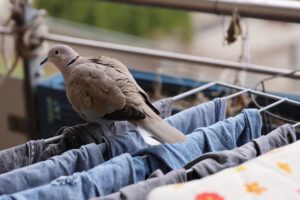
Turtle dove walking over the clothes hanging on the balcony cloth dryer. Urban wildlife. Birds in the city. Pigeon on the balcony looking for food. Jeans and t-shirts are hanging on the cloth dryer.
The misleadingly marketed Avitrol brand poison is used to kill pigeons. Promoted as a “flock frightening agent” or “repellent”, it is in fact a nervous system poison. Birds who consume it suffer convulsions and die. It is not only traumatic for the birds to die this way, but also for any people—especially children—who witness or try to help the dying birds.
Users claim that the distressed behavior of poisoned birds frightens other flock members away. Yet any “frightening” effect of Avitrol on surviving birds is very short-lived, because remaining birds return quickly and reproduce. Taking a small subset out of the population really doesn’t accomplish much other than opening up niche space for other birds to fill. The end result of the use of Avitrol or other lethal pigeon control methods is an endless cycle of unnecessary killing.
The HSUS also opposes the common practice of trapping and removing pigeons. Trapped birds are typically killed, and if not killed immediately, may be used in cruel pigeon shoots or live the remainder of their lives in permanent confinement. The removal of birds without getting at the cause of the conflict is a woefully inadequate approach to problem management.
Pigeon Patrol
Pigeon Patrol Products & Services is the leading manufacturer and distributor of bird deterrent (control) products in Canada. Pigeon Patrol products have solved pest bird problems in industrial, commercial, and residential settings since 2000, by using safe and humane bird deterrents with only bird and animal -friendly solutions. At Pigeon Patrol, we manufacture and offer a variety of bird deterrents, ranging from Ultra-flex Bird Spikes with UV protection, Bird Netting, 4-S Bird Gel and the best Ultrasonic and audible sound devices on the market today.
Canada’s top wholesaler for bird deterrent products for twelve consecutive years.
Contact us at 1- 877– 4– NO-BIRD, (604) 585-9279 or visit our website at https://www.pigeonpatrol.ca/
Bird Gone, Pigeon Gone, Pigeon problems, pigeon spikes, 1-877-4NO-BIRD, 4-S Gel, Bird Control, Pigeon Control, bird repellent, Bird Spikes, sonic bird repellent, stainless steel bird spikes, bird spikes Vancouver, Ultra Sonic Bird Control, Bird Netting, Plastic Bird Spikes, Canada bird spike deterrents, Pigeon Pests, B Gone Pigeon, Pigeon Patrol, pest controller, pest control operator, pest control technician, Pigeon Control Products, humane pigeon spikes, pigeon deterrents, pigeon traps, Pigeon repellents, Sound & Laser Deterrents, wildlife control, raccoon, skunk, squirrel deterrent, De-Fence Spikes, Dragons Den, Pigeon, Pigeon Patrol, Pigeons Roosting, Vancouver Pigeon Control, Bird Spikes, Bird Control, Bird Deterrent, Pigeon Deterrent, Surrey Pigeon Control, Pest, Seagull deterrent Vancouver Pigeon Blog, Birds Inside Home De-fence, Pigeon Nesting, Bird Droppings, Pigeon Dropping, woodpecker control, Keep The Birds Away, Birds/rats, seagull, pigeon, woodpecker, dove, sparrow, pidgeon control, pidgeon problem, pidgeon control, flying rats, pigeon Problems, bird netting, bird gel, bird spray, bird nails, bird guard, Pigeon control, Bird deterrents, Pigeon deterrents, Bird control, solutions, Pigeon prevention, Pigeon repellent, Bird proofing, Pest bird management, Pigeon spikes, Bird netting, Humane bird control, Bird exclusion, Urban bird control, Anti-roosting devices, Pigeon removal, Bird barriers
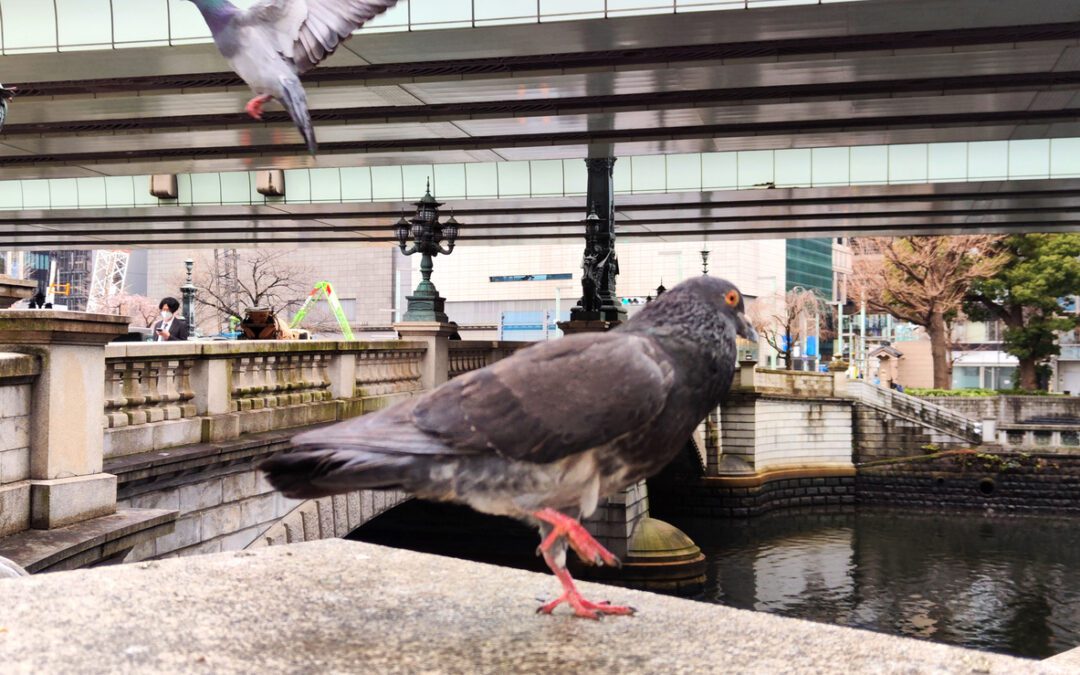
by Pigeon Patrol | Sep 25, 2024 | Bird Netting, Pigeon Droppings
From a pigeon’s perspective, city living can’t be beat. Food and water are readily available. Predators are rare. Plus, there’s plenty of free housing. Pigeons find our window ledges, rooftops, bridges, and warehouses to be ideal substitutes for the natural ledges in cliff sides that they have always used as roosting, nesting, and sheltering sites.
When flocks grow too large and become a nuisance, killing the birds is often the first plan of action. But killing pigeons doesn’t work, and there are better, non-lethal ways to fix a pigeon problem.
Three steps to humanely solve a pigeon problem
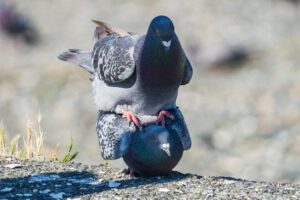
Pigeons mating and flirting with each other.
You may just need one or a combination of all three techniques, depending on the size of the pigeon population you’re dealing with.
Stop feeding the pigeons (intentionally or not)
Most conflicts with pigeons can be tied at one point or another to feeding, intentionally or otherwise.
Pigeons get fed plenty of handouts and garbage, but there are also well-intentioned pigeon lovers who regularly feed the birds. This does the pigeons more harm than good as the pigeons begin to gather in large numbers, often leading to inhumane and ineffective attempts to reduce their numbers.
When such troubles arise, the best thing for the birds is to reduce feeding gradually over several weeks. The flock will gradually disperse until the remaining number of birds matches what the area can naturally support.
Unintentional food sources
Even when not feeding on purpose, we humans are messy, leaving leftovers and dropped crumbs everywhere. Pigeons hang around town squares, public parks, and other trafficked areas to help themselves to what we leave behind, especially when convenient roosting and nesting sites are nearby. To discourage pigeons from gathering, food attractants need to be cleaned up regularly.
In suburban neighborhoods, too, homeowners may mistakenly feed pigeons or they may be providing food for pigeons inadvertently when feeding their backyard birds by tossing seed on the ground, rather than putting it in birdfeeders. To discourage pigeons visiting your yard, change the type, amount, and timing of feeding. If most of the pigeons fail to move elsewhere, you’ll need to stop feeding all birds for a couple weeks. (Don’t worry; the birds won’t starve.) When you resume feeding, only put out seed in birdfeeders and keep the ground below them cleaned up.
Prevent roosting and nesting
Pigeons look for flat surfaces for roosting and nesting. Encourage them to do these things elsewhere by making flat surfaces unavailable to them. With the correct application of the right product, roosting structures can be rendered virtually pigeon-free.
There are a variety of devices that can be used to change flat nesting spots into inaccessible spaces and prevent pigeons from roosting in areas where they’re not wanted. Attach wood or metal sheathing (Birdslides) at a 45- to 60-degree angle over window ledges and other flat surfaces to keep pigeons from landing.
Install “bird wires” to keep pigeons off ledges, railings, awnings, and rooftops.
Use netting to keep pigeons out of large areas.
NEVER use polybutylene gel. Sticky gel repellents made from polybutene can harm all birds and any animal that comes in contact with it. The HSUS strongly recommends that these dangerous repellents be avoided at all costs. The feathers of any bird who comes into contact with the dense, sticky gel will become damaged, interfering with their ability to fly and to stay water-proofed.
These gel repellents are not selective. Other birds are likely to land on the gel, get stuck, and die a slow death. The polybutene gels are particularly harmful to smaller species.
Limit flock size with pigeon birth control
As year-round nesters, a pair of pigeons can raise a dozen or more young each year. If pigeons have plenty of food and space, their numbers can quickly increase. Fortunately, a bird contraceptive is available that limits growth of pigeon flocks.
Ovocontrol bird food is “birth control” for pigeons. Innolytics, LLC
Known as OvoControl, pigeon contraception comes in the form of a kibble-type food, which causes birds who eat it regularly to lay eggs that fail to develop. In March 2010, OvoControl received landmark general-use approval by the Environmental Protection Agency. Visit ovocontrol.com to learn more about the product and how you can implement an OvoControl program.
Combined with exclusion and other humane measures to discourage roosting and nesting, OvoControl effectively reduces hatching rates in pigeons, thereby limiting flock sizes and diminishing problems associated with large numbers of pigeons.
Business owners who pledge to use OvoControl instead of lethal methods can download our free signage and educational materials. In Hawai’i, where pigeons can be a major problem, businesses that have started OvoControl programs have seen a noticeable decrease in pigeon numbers.
M=====
Pigeon droppings and public health
Disease risk from pigeon droppings is often used to justify killing pigeons, but fresh bird droppings have not been shown to present a health risk.
People may fear that pigeons roosting or nesting nearby, or more specifically the droppings that accompany such sites, are a health threat. These fears usually focus on histoplasmosis, a fungus that grows in dropping-enriched soil, and on diseases caused by Cryptococcus and Salmonella. However, there is little evidence linking pigeons directly to human infections.
Histoplasmosis fungus is common in the eastern and central U.S. As many as 80 % of people tested in these areas prove to have already been exposed to the fungus without knowing.
According to the Centers for Disease Control, fresh bird droppings on surfaces such as sidewalks and windowsills have not been shown to present a health risk. People should avoid contact with any animal droppings, of course, and ordinary good hygiene, such as washing hands and leaving shoes at the door, are adequate prevention if you accidentally come into contact with animal droppings.
Pigeon Patrol
Pigeon Patrol Products & Services is the leading manufacturer and distributor of bird deterrent (control) products in Canada. Pigeon Patrol products have solved pest bird problems in industrial, commercial, and residential settings since 2000, by using safe and humane bird deterrents with only bird and animal -friendly solutions. At Pigeon Patrol, we manufacture and offer a variety of bird deterrents, ranging from Ultra-flex Bird Spikes with UV protection, Bird Netting, 4-S Bird Gel and the best Ultrasonic and audible sound devices on the market today.
Canada’s top wholesaler for bird deterrent products for twelve consecutive years.
Contact us at 1- 877– 4– NO-BIRD, (604) 585-9279 or visit our website at https://www.pigeonpatrol.ca/
Bird Gone, Pigeon Gone, Pigeon problems, pigeon spikes, 1-877-4NO-BIRD, 4-S Gel, Bird Control, Pigeon Control, bird repellent, Bird Spikes, sonic bird repellent, stainless steel bird spikes, bird spikes Vancouver, Ultra Sonic Bird Control, Bird Netting, Plastic Bird Spikes, Canada bird spike deterrents, Pigeon Pests, B Gone Pigeon, Pigeon Patrol, pest controller, pest control operator, pest control technician, Pigeon Control Products, humane pigeon spikes, pigeon deterrents, pigeon traps, Pigeon repellents, Sound & Laser Deterrents, wildlife control, raccoon, skunk, squirrel deterrent, De-Fence Spikes, Dragons Den, Pigeon, Pigeon Patrol, Pigeons Roosting, Vancouver Pigeon Control, Bird Spikes, Bird Control, Bird Deterrent, Pigeon Deterrent, Surrey Pigeon Control, Pest, Seagull deterrent Vancouver Pigeon Blog, Birds Inside Home De-fence, Pigeon Nesting, Bird Droppings, Pigeon Dropping, woodpecker control, Keep The Birds Away, Birds/rats, seagull, pigeon, woodpecker, dove, sparrow, pidgeon control, pidgeon problem, pidgeon control, flying rats, pigeon Problems, bird netting, bird gel, bird spray, bird nails, bird guard, Pigeon control, Bird deterrents, Pigeon deterrents, Bird control, solutions, Pigeon prevention, Pigeon repellent, Bird proofing, Pest bird management, Pigeon spikes, Bird netting, Humane bird control, Bird exclusion, Urban bird control, Anti-roosting devices, Pigeon removal, Bird barriers










